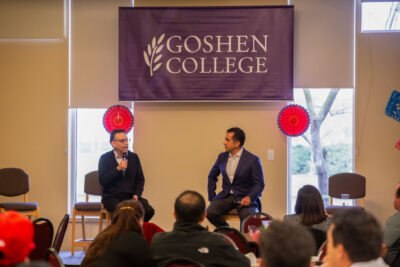In an effort to reduce its mowed lawns, the campus is planning to introduce native grasses and wild flowers to replace seven acres of the current turf on campus. The areas to be converted include the entire railroad corridor, the large lawn north of the Kratz and Miller dorms, much of the lawn west of the Music Center, areas along 12th Street and the east border of the athletic fields.
Currently, the physical plant is mowing 55 acres of grass, including athletic fields. According to Glenn Gilbert, the sustainability coordinator, the plan to reduce this area by 12 percent will have both economic and environmental benefits.
The Physical Plant has recently had a significant reduction in staffing, said Gilbert, providing less people to maintain the lawns. The native landscaping plan would need less maintenance and would reduce the need for chemicals and fertilizer. Gilbert estimated it will take about three years to earn back the money put into installing the prairies. From an environmental standpoint, the new landscaping would reduce water runoff, reduce the use of fuel and create a natural habitat for animals.
Because the campus is within the city limits of Goshen, the college must obtain a variance to the existing city ordinance regarding rank vegetation and noxious weeds. This ordinance imposes restrictions on the height of grass and conditions for un-mowed vegetation. Gilbert anticipates that the variance will be granted, allowing for a late April or early May starting date.
"The first step will be to kill the existing turf with a chemical herbicide so the new seeds will have a chance to get well established. The first year or two will look rough and it will probably look like we're just growing weeds," said Gilbert. "It's important for people to have informed perspectives so they aren't expecting lush, grassy fields in the first year. It doesn't work like that." Gilbert explained the prairie will begin to shape after two or three years, and it could keep changing in form for up to ten years before it is really established.
"There will still be plenty of traditional lawn space," he said. "We tried to choose areas that people don't use normally."
Although native landscaping is still a relatively new idea, Gilbert said there are a number of places in the area that have already converted to prairies. Associated Mennonite Biblical Seminary in Elkhart has a well-established prairie. J.F. New, a company that has done a lot of native plantings in the area, will be doing the actual planting.
Green flags have been placed throughout campus to mark the tentative spots to be converted.
"We haven't settled on an exact mix of seeds to be used and the locations could still change," said Gilbert. "If people on campus are interested, it would be possible to create a small group to talk about our plan of action."
Gilbert will give an informational presentation about the plan on at 7 p.m. on Thursday, Sept. 9 in SC 107.

